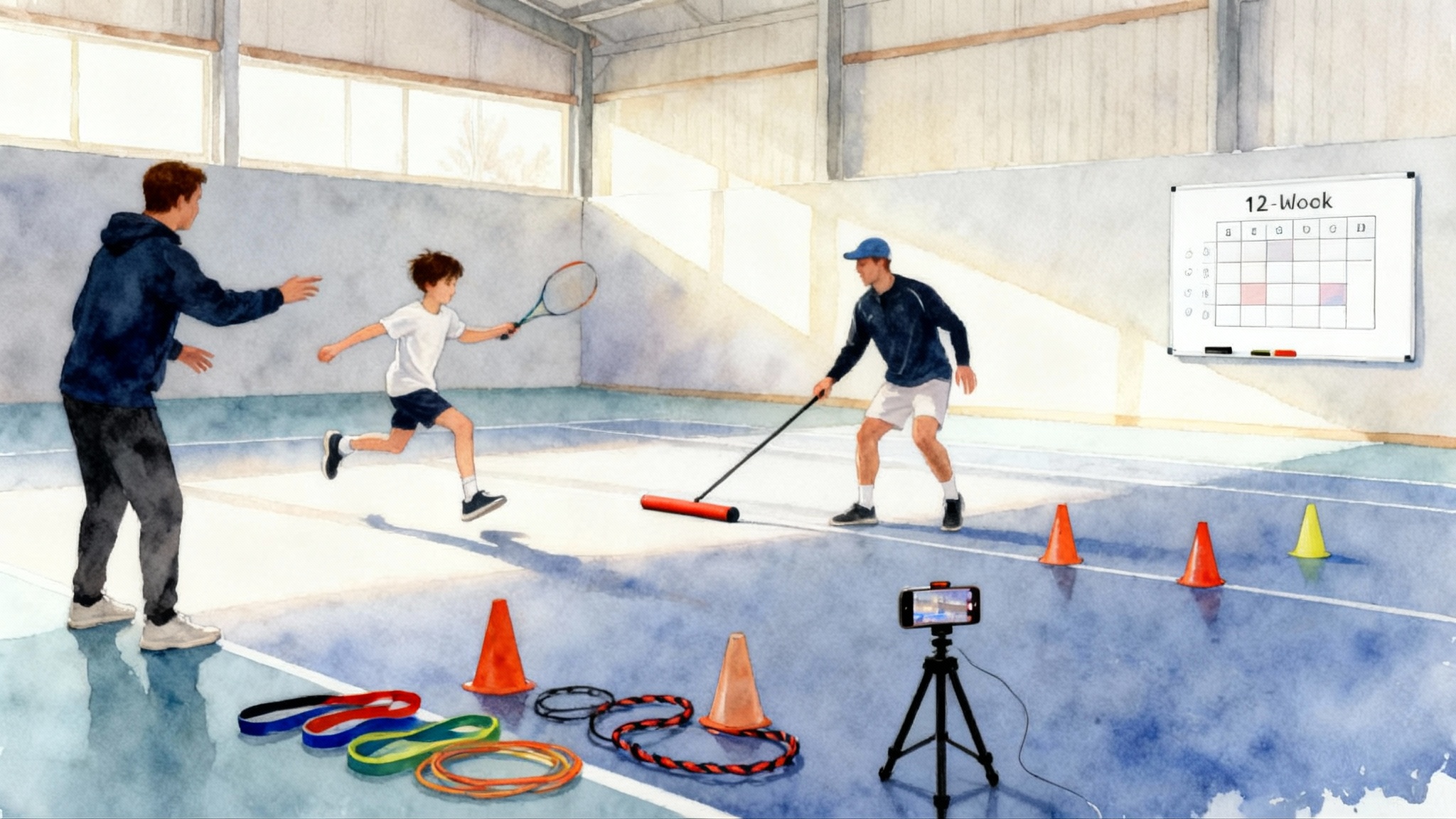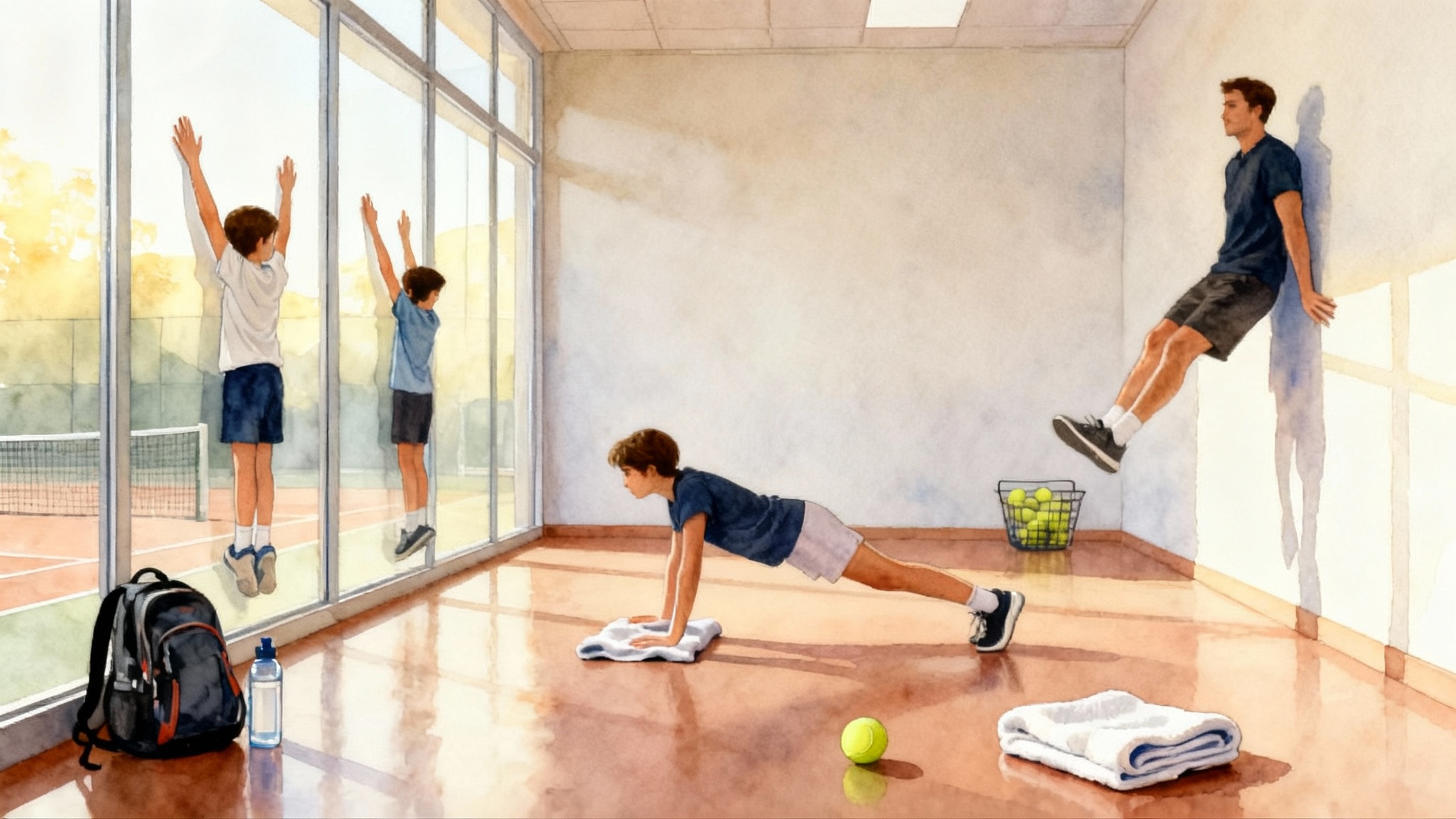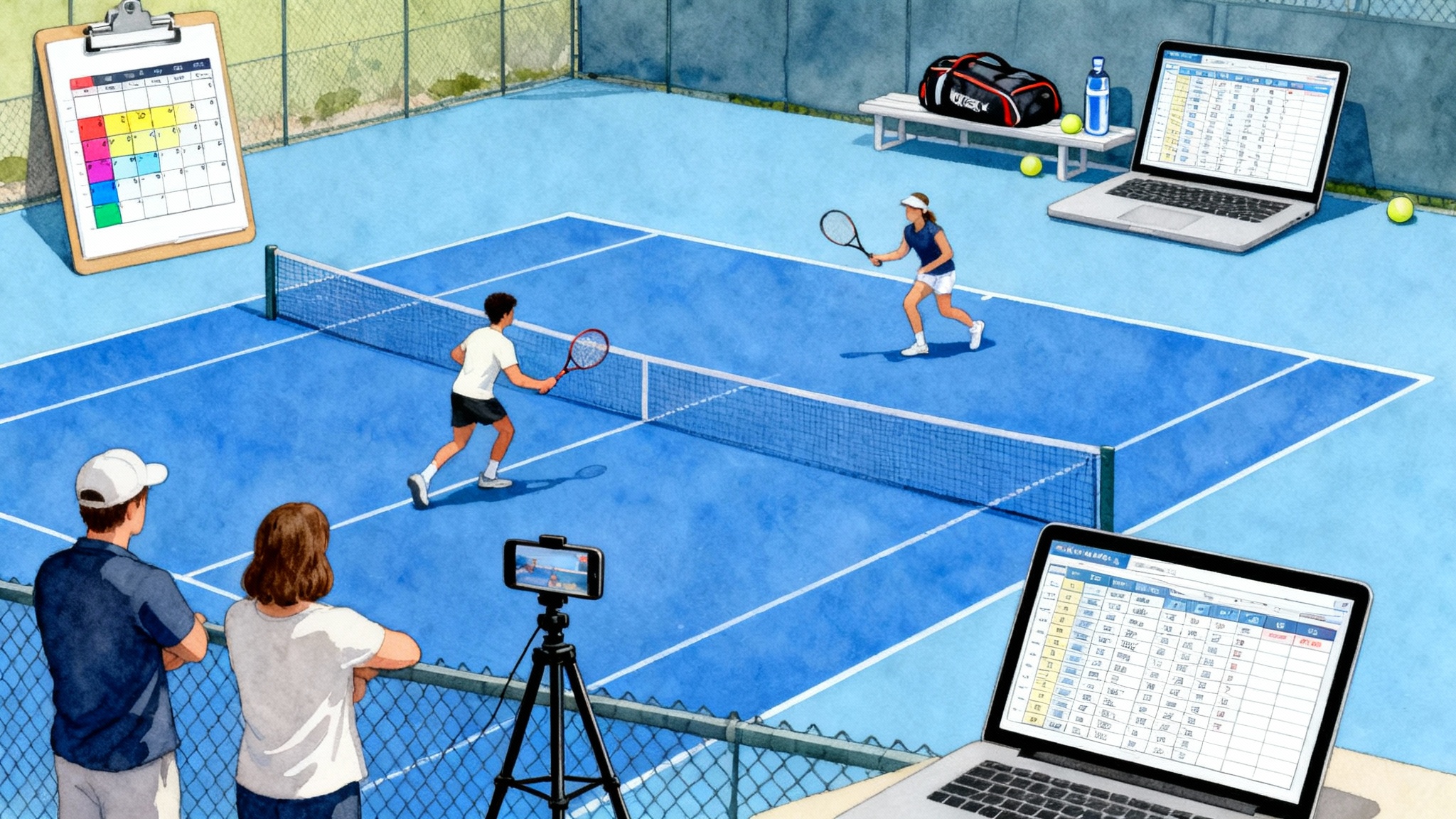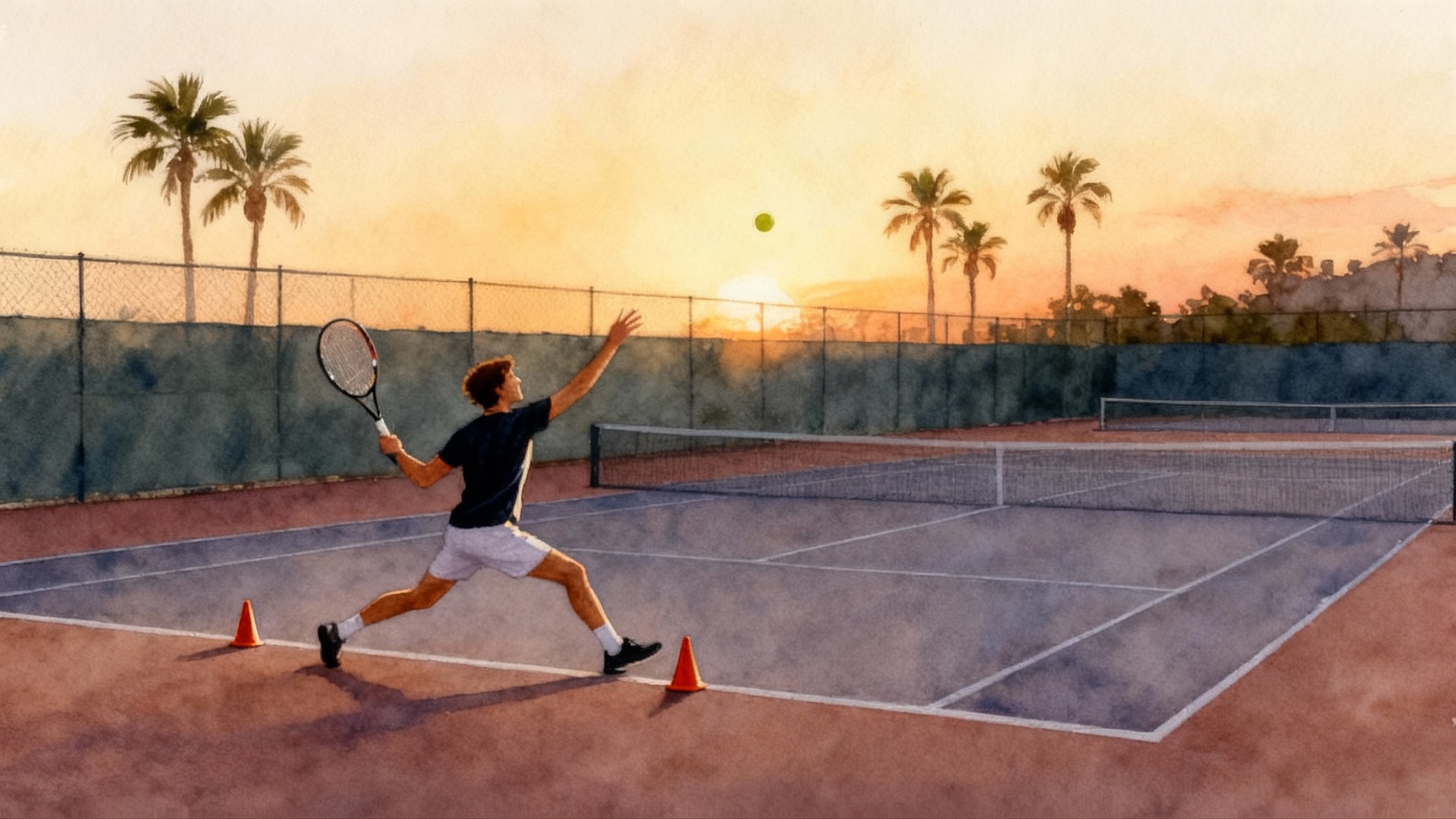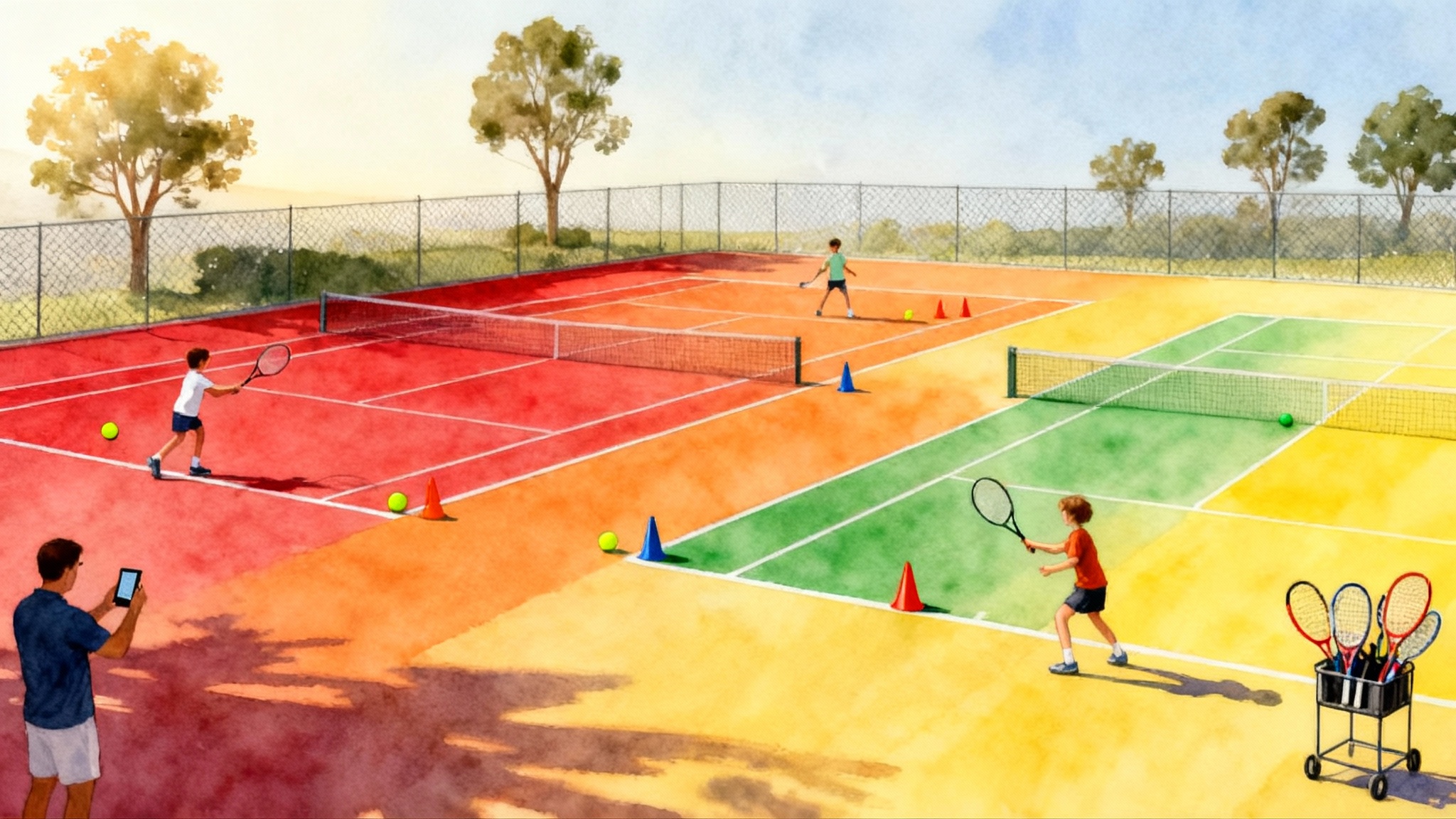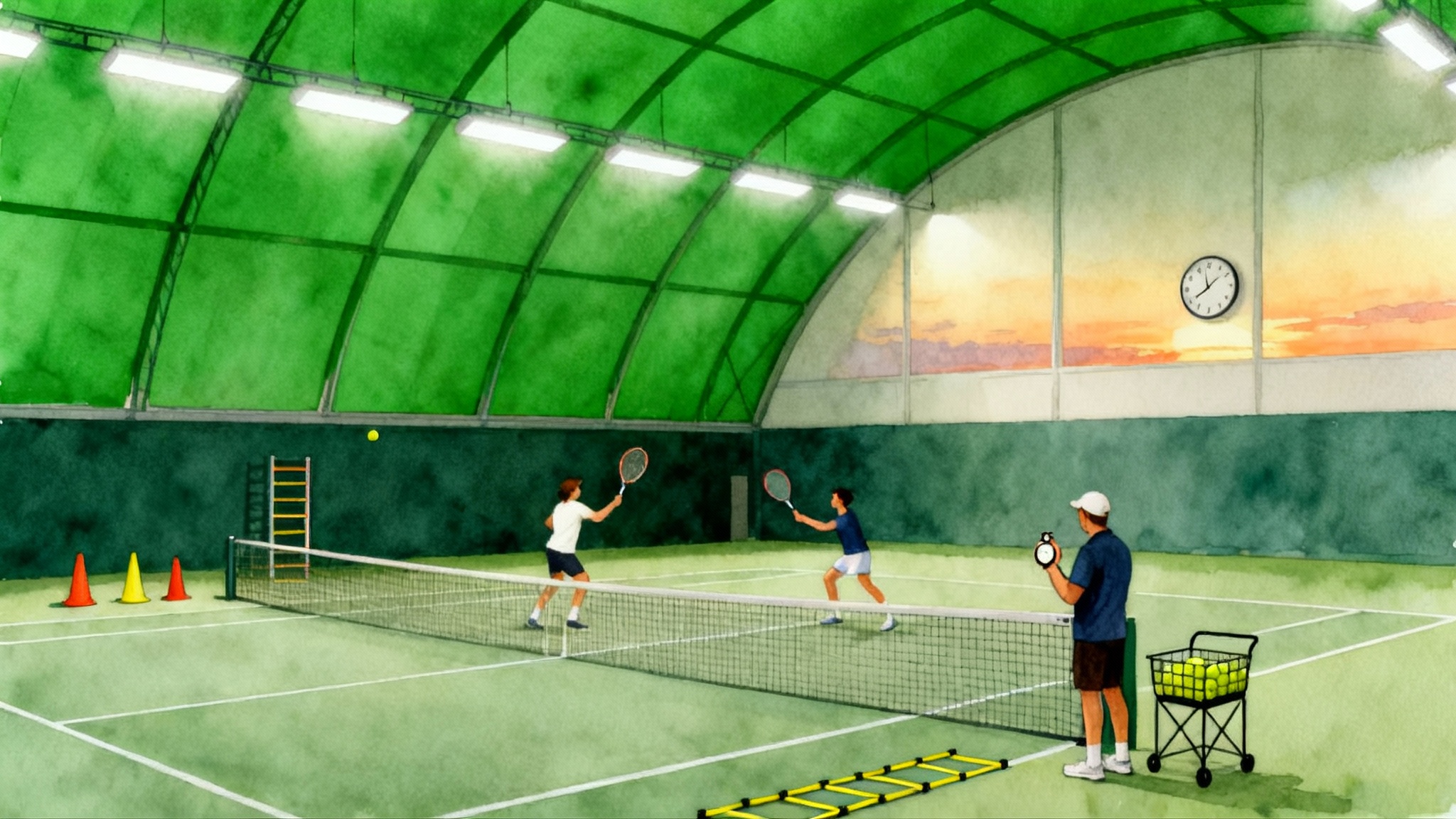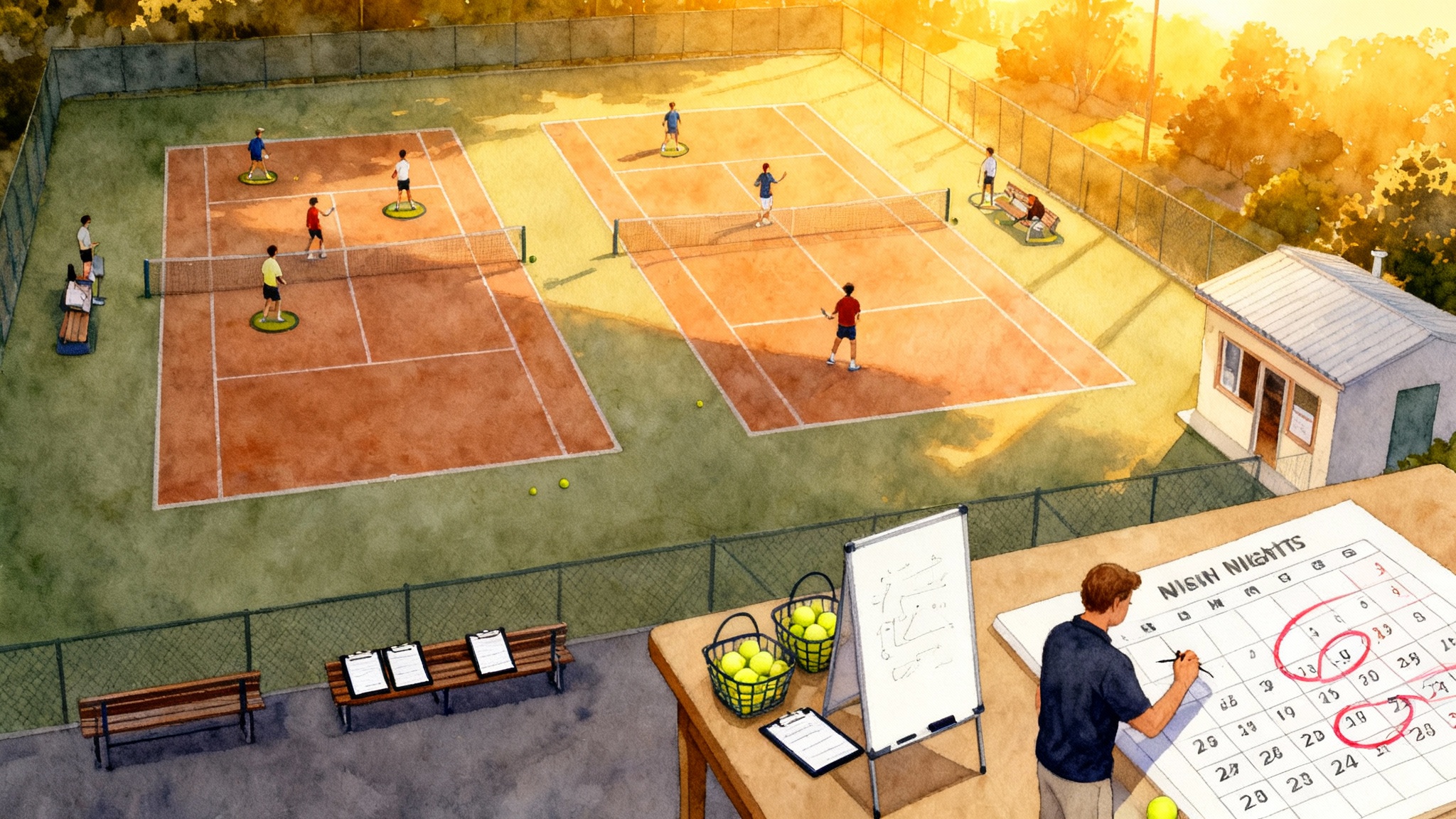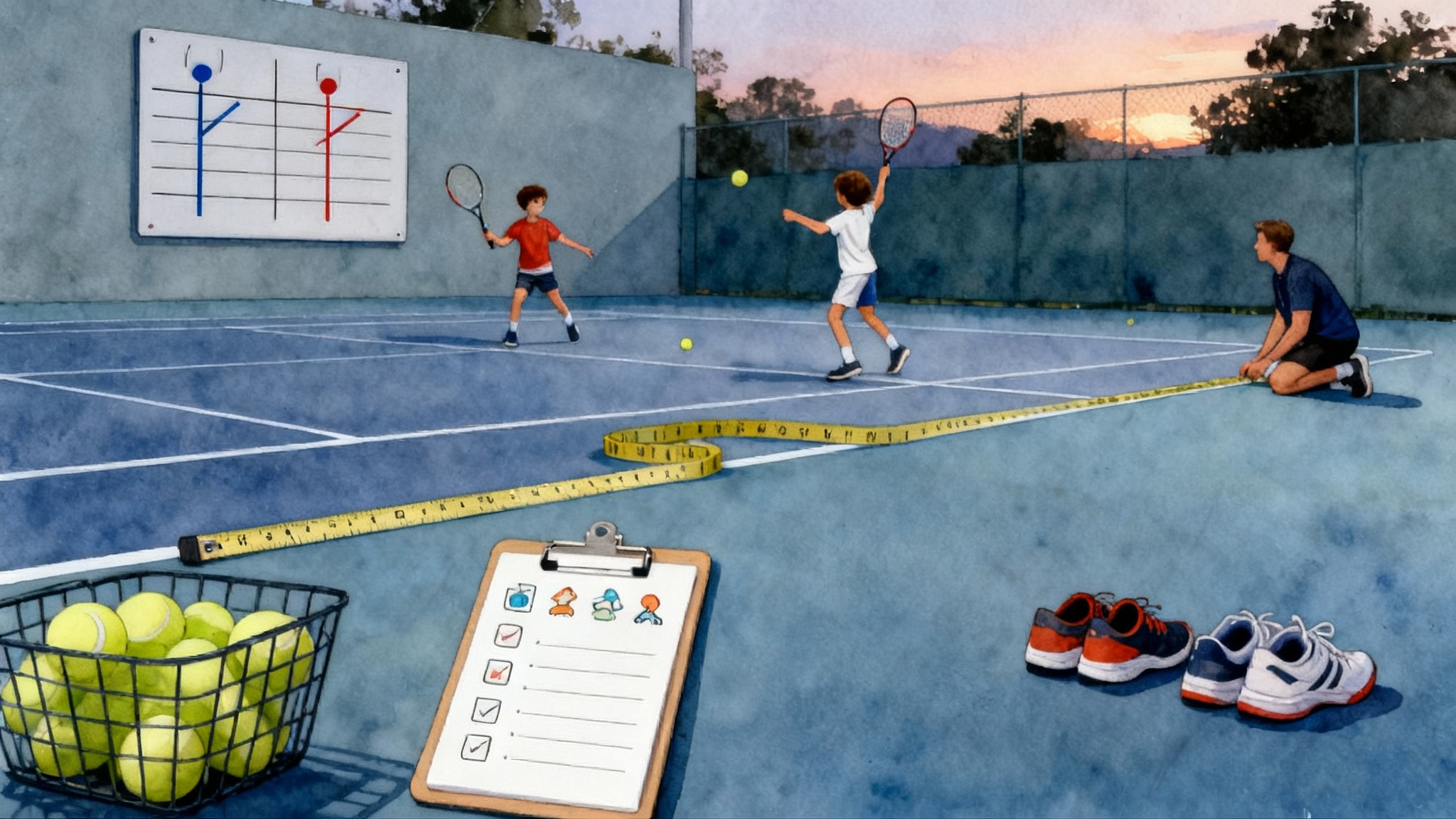Footwork First: 5 Tennis Patterns, from Split Step to Shuffle
Master the split step, first-step acceleration, crossover, drop-step, and lateral shuffle with equipment-light drills, indoor and outdoor tweaks, age-specific 15-minute add-ons, and clear benchmarks. Book a Sarasota assessment today.
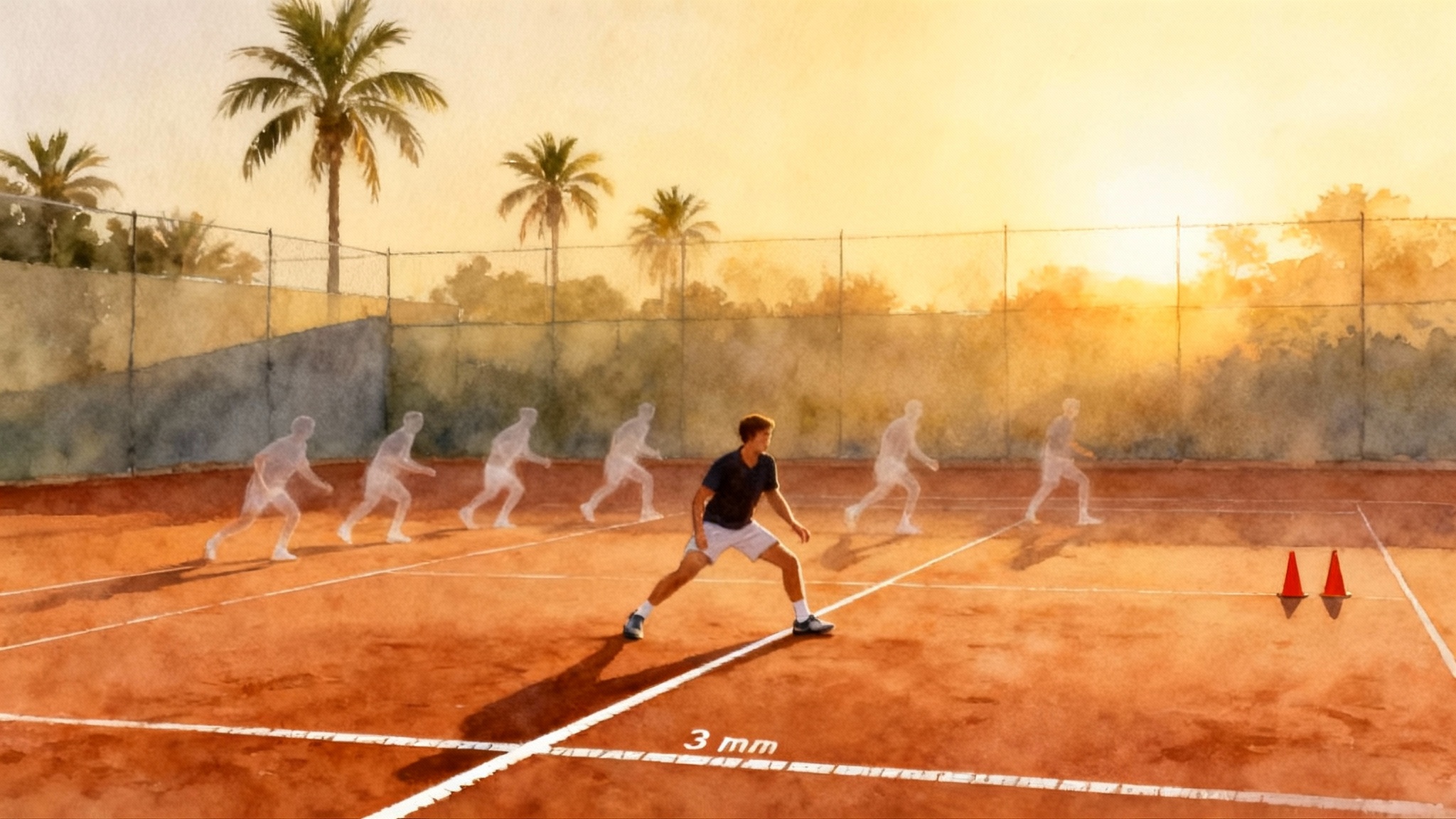
Why footwork first
Racquet skills win points only after your feet put you in the right place. Footwork is the transmission that turns intent into clean contact. The fastest way to look and feel more skilled is to master five movement patterns that show up in every rally: the split step, first-step acceleration, crossover, drop-step, and lateral shuffle. Research on high-level players shows that a well-timed split step shortens reaction time and sets up faster lateral moves, which means more balls reached and fewer late swings. See this ITF study on split-step timing.
This guide is equipment-light, works indoors or outdoors, and packs into 15-minute add-on routines. You will finish with a movement screen, simple benchmarks by age and level, and clear steps to book a footwork assessment in Sarasota.
Quick movement screen checklist
Run this simple checklist before you start. If two or more items feel tight or unsteady, begin with the low-impact versions in each drill.
- Ankles: You can do 10 slow calf raises per side without wobbling.
- Hips: You can sit into a wall squat for 30 seconds without knees collapsing inward.
- Core: You can hold a front plank for 30 seconds while breathing through the nose.
- Balance: You can stand on one leg for 20 seconds, eyes forward, without tapping down.
- Readiness: You can bounce lightly and land quietly on the balls of the feet.
The five patterns that run the sport
Think of these patterns as your alphabet. Every rally spells different words, but the letters repeat. Master each letter, then connect them.
1) The split step
What it is: A small, two-foot hop that lands just before your opponent contacts the ball. It resets balance and primes your first step. For deeper application on returns, see split-step timing on returns.
When to use it: Before every opponent contact in both baseline and net play. On returns, time your landing as the serve crosses the net.
Coaching cues:
- Ears up, eyes forward, hands alive.
- Hop small. Land on the balls of the feet, heels hovering.
- Land as the opponent strikes the ball, not after.
Common errors and fixes:
- Late landing: reduce hop height and start sooner.
- Heavy heels: imagine your shoes have paint on the toes you do not want to smudge.
At-home drill (no court): Set two tea towels two shoe-lengths apart. Hop lightly between them for 30 seconds, rest 15 seconds, repeat 4 times. On each landing, freeze for a beat, then push a small step to the left or right.
Indoor or outdoor tweak: Indoors, shorten the hop and focus on quiet landings. Outdoors, add a slight forward lean to prepare for acceleration.
Simple benchmark: Perform 30 controlled split steps in 30 seconds with clean posture and soft landings.
2) First-step acceleration
What it is: Your very first push after the split. It sets your line, speed, and balance.
When to use it: Any time you decide to move, especially on wide balls and short balls.
Coaching cues:
- Nose over toes. Lead with the hips.
- Push the ground away with the inside edge of the foot.
- Keep the racquet head up so the arms do not slow the legs.
Common errors and fixes:
- Reaching with the foot: instead, drive from the back leg.
- Standing tall: keep a slight forward torso angle.
At-home drill (wall start): Stand arm’s length from a wall. Lean forward into the wall with straight arms and a flat back. Drive one knee up and switch quickly for 20 seconds, rest 20 seconds, repeat 4 times.
Indoor or outdoor tweak: On slick floors, shorten strides and increase turnover. On gritty courts, push longer and lower.
Simple benchmark: From a standing start, cover 3 meters in 1.2 to 1.6 seconds depending on age and level. See the benchmarks section for details.
3) The crossover step
What it is: A quick crossing of the outside leg over the inside leg to gain ground laterally without turning fully to sprint.
When to use it: After the split when defending wide balls, and when recovering from the outside back toward center.
Coaching cues:
- Tall chest, low hips.
- Cross over, then open the hips if you need more speed.
- Keep the head level so the eyes stay steady on the ball.
Common errors and fixes:
- Over-rotating the torso: keep shoulders square until you choose to sprint.
- Shuffling only: if the ball is far, cross first, then shuffle to fine tune.
At-home drill (two-cone lane): Place two cones 2 meters apart. From the middle, split, then cross over to one cone, touch low, cross back, touch the other, and repeat for 20 seconds. Rest 20 seconds. Do 4 sets.
Indoor or outdoor tweak: Indoors, use socks on carpet only if stable. Outdoors, widen your base to handle grip changes.
Simple benchmark: In 20 seconds, complete at least 10 clean crossovers to touch cones 2 meters apart without tripping or crossing feet too close.
4) The drop-step
What it is: A small outward pivot of the lead foot that lets you open the hips and escape quickly on deep drives or lobs.
When to use it: On balls that get behind you or when you need emergency space to swing.
Coaching cues:
- Think door hinge: the lead foot turns as the hips open.
- Keep the center of mass low and go immediately.
- Do not step backward with straight legs. Bend and pivot.
Common errors and fixes:
- Stepping back with both feet: pivot first to save time.
- Leaning back: stay slightly forward to keep balance while retreating.
At-home drill (chalk mark): Mark a T on the floor. Stand at the base. On a clap or timer beep, drop-step the right foot to the side line and run two steps backward, then return. Alternate sides for 6 repetitions each.
Indoor or outdoor tweak: Indoors, keep the steps short to prevent slipping. Outdoors, add a small crossover after the drop-step for speed.
Simple benchmark: Execute 6 clean drop-steps per side in under 20 seconds with no heel collisions.
5) The lateral shuffle
What it is: Side-to-side movement that keeps the hips square to the net while you track and recover.
When to use it: Recovery after a wide ball, positioning as you track crosscourt rallies, and at the net.
Coaching cues:
- Feet under hips, toes slightly out.
- Push, then glide. Do not click heels.
- Stay level. Quiet head equals stable eyes.
Common errors and fixes:
- Clicking heels or crossing feet: keep a fist-width gap between shoes.
- Bouncing up and down: reduce vertical movement to save energy.
At-home drill (line shuttle): Draw a 3 meter line. Shuffle left and right, touch each end with your outside hand, for 20 seconds. Rest 20 seconds. Do 4 sets. The United States Tennis Association has clear descriptions of recovery moves in its coaching library; see the United States Tennis Association footwork overview for definitions and context.
Indoor or outdoor tweak: Indoors, value rhythm and posture more than speed. Outdoors, add a final plant-and-push to simulate recovery to center.
Simple benchmark: 16 clean touches in 20 seconds over 3 meters without crossing feet.
At-home micro equipment list
- Two cones or plastic cups. Two tea towels also work.
- Painter’s tape or chalk for lines.
- A safe wall for shadow swings and timing.
- A smartphone timer or metronome at 60 to 80 beats per minute.
Fifteen-minute add-on routines
These plug into any practice or workout. Choose your track, then follow the clock. Each includes a short warm-up and a short cool-down.
Junior track (ages 8 to 14)
- Minute 0 to 3: Bounce and split. Ten seconds on, ten off. Focus on soft landings.
- Minute 3 to 6: First-step races. Three meters on a whistle. Walk back. Ten reps.
- Minute 6 to 9: Two-cone crossover lane. Twenty seconds on, twenty off, two sets.
- Minute 9 to 12: Drop-step escapes. Six per side from a clap, rest as needed.
- Minute 12 to 14: Lateral shuffle line. Twenty seconds on, twenty off, one set.
- Minute 14 to 15: Breathing walk and tall posture reset.
Coaching notes for parents: Praise quiet feet and stable eyes rather than speed. If attention fades, turn it into a game of tag across the cones.
Parent track (family session)
- Minute 0 to 2: Joint warm-up. Marching skips, arm circles, ankle rolls.
- Minute 2 to 5: Partner split-step timing. One parent tosses from the service line while the other lands on contact and moves two steps to catch.
- Minute 5 to 8: First-step mirror. Face each other. Leader feints left or right. Partner reacts with a single powerful step.
- Minute 8 to 11: Crossover and shuffle relay. Two cones 3 meters apart. Alternate crossovers and shuffles for 20 seconds each.
- Minute 11 to 14: Drop-step lob chase. One parent hand-feeds a mini lob. Partner drop-steps and retreats two steps, then shadow swings.
- Minute 14 to 15: High-five cooldown walk.
Safety tip: Keep the intensity submaximal indoors and on unfamiliar surfaces.
Adult performance track
- Minute 0 to 3: Elastic warm-up. Skips A and C with short ground contacts.
- Minute 3 to 6: Reactive split. Partner calls left, right, short, or back at random. You land and go.
- Minute 6 to 9: Three-meter first-step blasts. Four sets of three reps. Walk back recovery.
- Minute 9 to 12: Crossover plus plant. Cross two steps, plant, then shuffle three counts. Repeat both directions.
- Minute 12 to 14: Drop-step into recovery. Drop-step two counts, crossover two counts, shuffle two counts, plant and set.
- Minute 14 to 15: Box breathing and posture reset.
Cone and wall options for small spaces
If you are indoors with little room, run this five-minute block at the end of any session:
- Minute 0 to 1: Split-step on a metronome at 70 beats per minute. Land on every second tick.
- Minute 1 to 2: Wall lean switches. Drive knees for quick turnover.
- Minute 2 to 3: Micro crossovers around a single cone. Trace a tight figure eight.
- Minute 3 to 4: Drop-step to wall touch. Pivot, back up two steps, touch, return.
- Minute 4 to 5: Lateral micro-shuffle along a taped 2 meter line, quiet feet.
Age and level benchmarks
These are simple targets that track progress. Use what fits your context. Test once every four weeks after a light warm-up.
-
Split step endurance: 30 controlled reps in 30 seconds
- Ages 8 to 10: pass at 22 or more
- Ages 11 to 14: pass at 26 or more
- High school and adult recreational: pass at 28 or more
- Adult competitive: pass at 30 with quiet landings
-
Three-meter first step time (from split): best of three trials
- Ages 8 to 10: 1.8 to 2.1 seconds
- Ages 11 to 14: 1.5 to 1.8 seconds
- High school and adult recreational: 1.3 to 1.6 seconds
- Adult competitive: 1.2 to 1.4 seconds
-
Crossover touches in 20 seconds over 2 meters
- Ages 8 to 10: 8 to 10
- Ages 11 to 14: 10 to 12
- High school and adult recreational: 12 to 14
- Adult competitive: 14 to 16
-
Drop-step repeats, 6 per side, clean pivots with no heel collisions
- Ages 8 to 10: under 28 seconds
- Ages 11 to 14: under 24 seconds
- High school and adult recreational: under 22 seconds
- Adult competitive: under 20 seconds
-
Lateral shuffle touches in 20 seconds over 3 meters
- Ages 8 to 10: 12 to 14
- Ages 11 to 14: 14 to 16
- High school and adult recreational: 16 to 18
- Adult competitive: 18 to 20
Use a phone camera from the side. Look for quiet head, low hips, and clean footwork. If times plateau but form improves, that is still progress.
Common pattern connections during points
- Return of serve: split step as the ball crosses the net, first-step acceleration to the backhand corner, crossover to recover.
- Wide rally ball: split, crossover to reach, plant, strike, shuffle to center.
- Lob defense: split, immediate drop-step, crossover, then controlled shuffle to set the feet.
- Net exchange: micro split at opponent’s contact, first-step to cut the angle, short shuffle to fine tune.
Practicing the connections makes the patterns automatic under pressure.
Indoor and outdoor tweaks that matter
For seasonal adjustments and court changes, use our fall transition footwork plan.
-
Surfaces
- Hardwood or tile: shorten ground contact, reduce hop height, and wear grippy shoes.
- Clay: lower center of mass and accept slight slides with strong deceleration.
- Hard courts: emphasize soft landings and recovery angles to protect joints.
-
Weather
- Heat: shorten sets, increase rest, and replace one speed set with timing-only split steps.
- Wind: practice first-step acceleration into and with the wind so you learn to lean correctly.
-
Space
- Small room: use tea towels instead of cones and shadow swing instead of feeding.
- Full court: extend shuffles to 4 or 5 meters and add a recovery plant at center.
How to progress each pattern in two weeks
- Week 1 focus: position and posture. Film a 10 second clip of each drill and check head level, hip height, and foot placement.
- Week 2 focus: timing and intent. Add a clap or visual cue on partner contact for the split and first step.
Small rule: never add speed before you own quiet landings and clean direction changes. For a broader base-building approach, see Off-Season training for all ages.
Book a footwork assessment in Sarasota
If you want expert eyes on your movement, a structured test of these five patterns, and a personal plan you can run in fifteen minutes a day, book with the Celsius Tennis Academy in Sarasota. Sessions include a timed baseline, slow-motion video clips, and a progression you can do at home with cones and a wall.
Final rally
Great footwork is not a mystery. It is five patterns practiced on purpose, for a few minutes at a time, in spaces you already have. Start with the split step. Add a crisp first step. Cross over for distance, drop-step for space, and shuffle to fine tune. Test yourself against simple benchmarks, then nudge them forward every month. If you want a coach to measure and accelerate your progress, book a footwork assessment in Sarasota and turn your movement into a competitive edge.
